Related Research Articles
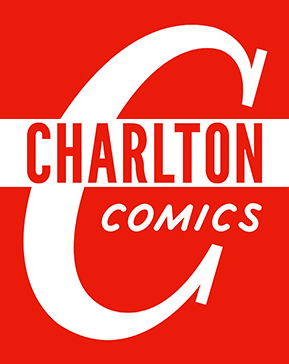
Charlton Comics was an American comic-book publishing company that existed from 1945 to 1986, having begun under a different name: T. W. O. Charles Company, in 1940. It was based in Derby, Connecticut. The comic-book line was a division of Charlton Publications, which published magazines, puzzle books, and briefly, books. It had its own distribution company.
Disney comics are comic books and comic strips featuring characters created by the Walt Disney Company, including Mickey Mouse, Donald Duck and Uncle Scrooge.

The Phantom is an American adventure comic strip, first published by Lee Falk in February 1936. The main character, the Phantom, is a fictional costumed crime-fighter who operates from the fictional African country of Bangalla. The character has been adapted for television, film and video games.
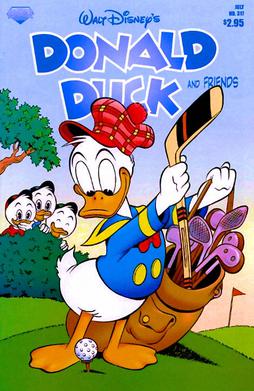
Donald Duck, also known as Donald Duck and Friends, is an American Disney comic book series starring the character Donald Duck and published by various publishers from October 1942 to June 2017. As with many early Disney comics titles, Donald Duck began as individual issues of Dell Comics' Four Color one-shots series. It was published as its own regular series in November 1952, starting with issue #26.

James N. Aparo was an American comic book artist, best known for his DC Comics work from the late 1960s through the 1990s, including on the characters Batman, Aquaman, and the Spectre, along with famous stories such as The Brave and the Bold, "A Death in the Family", and "KnightFall".
Frank W. Bolle was an American comic-strip artist, comic book artist and illustrator, best known as the longtime artist of the newspaper strips Winnie Winkle and The Heart of Juliet Jones; for stints on the comic books Tim Holt and Doctor Solar, Man of the Atom; and as an illustrator for the Boy Scouts of America magazine Boys' Life for 18 years. With an unknown writer, he co-created the masked, Old West comic-book heroine the Black Phantom. Bolle sometimes used the pen name FWB and, at least once, F. L. Blake.
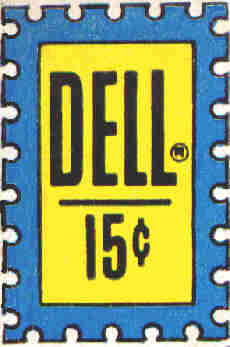
Dell Comics was the comic book publishing arm of Dell Publishing, which got its start in pulp magazines. It published comics from 1929 to 1974. At its peak, it was the most prominent and successful American company in the medium. In 1953 Dell claimed to be the world's largest comics publisher, selling 26 million copies each month.

Gold Key Comics was an imprint of American company Western Publishing, created for comic books distributed to newsstands. Also known as Whitman Comics, Gold Key operated from 1962 to 1984.

Alfonso Williamson was an American cartoonist, comic book artist and illustrator specializing in adventure, Western, science fiction and fantasy.

Atlas Comics was the 1950s comic-book publishing label that evolved into Marvel Comics. Magazine and paperback novel publisher Martin Goodman, whose business strategy involved having a multitude of corporate entities, used Atlas as the umbrella name for his comic-book division during this time. Atlas evolved out of Goodman's 1940s comic-book division, Timely Comics, and was located on the 14th floor of the Empire State Building. This company is distinct from the 1970s comic-book company, also founded by Goodman, that is known as Atlas/Seaboard Comics.
Indrajal Comics was a comic book series in India launched by the publisher of The Times of India, Bennet, Coleman & Co in March 1964. The first 32 issues contained Lee Falk's The Phantom stories, but thereafter, the title alternated between various King Features characters, including Lee Falk's Mandrake, Alex Raymond's Flash Gordon, Rip Kirby and Phil Corrigan, Roy Crane's Buz Sawyer, Allen Saunders' Mike Nomad,Kerry Drake, and Steve Dowling's Garth. Later in December 1976, it also published Bahadur, an Indian comic hero created by Aabid Surti.

The Many Ghosts of Doctor Graves was an American supernatural-anthology comic book published by Charlton Comics, often featuring stories by writer-artist Steve Ditko. The eponymous Dr. M. T. Graves was a fictional character who hosted the stories in each issue of this title, and very occasionally took part in a tale.
Aaron P. "Pat" Boyette was an American broadcasting personality and news producer, and later a comic book artist best known for two decades of work for Charlton Comics, where he co-created the character the Peacemaker. He sometimes used the pen names Sam Swell, Bruce Lovelace, and Alexander Barnes.

Tarzan, a fictional character created by Edgar Rice Burroughs, first appeared in the 1912 novel Tarzan of the Apes, and then in 23 sequels. The character proved immensely popular and quickly made the jump to other media, including comics.
Notable events of 1966 in comics.
Alan Class Comics was a British comics publishing company that operated between 1959 and 1989. The company produced anthology titles, reprinting comics stories from many U.S. publishers of the 1940s to 1960s in a black and white digest size format for a UK audience. During the 1960s and 1970s, these reprints were the main medium through which British children were introduced to American monster and mystery comics, as well as most non-DC or Marvel superheroes.
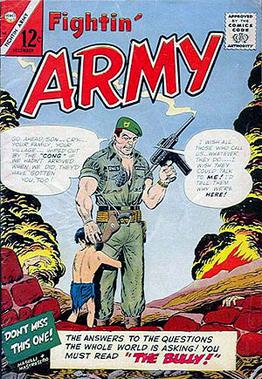
Fightin' Army was a bimonthly war comic published by Charlton Comics from 1956–1984. Telling fictional stories of the United States Army, it was a sister title of the other Charlton war comics Fightin' Air Force, Fightin' Marines, and Fightin' Navy.
Carl T. Pfeufer was an American comic-book artist, magazine illustrator, painter, and sculptor. He was an early contributor to American comic books; one of the primary early artists of the Marvel Comics superhero the Sub-Mariner; and the longtime artist of Western hero Tom Mix's comic books.
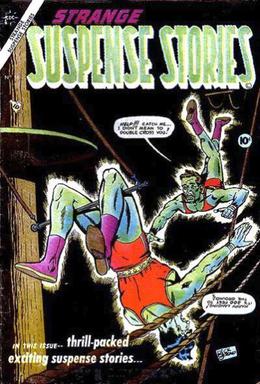
Strange Suspense Stories was a comic book published in two volumes by Fawcett Comics and Charlton Comics in the 1950s and 1960s. Starting out as a horror/suspense title, the first volume gradually moved toward eerie fantasy and weird science fiction, before ending as a vehicle for the superhero Captain Atom. The title's second volume was more in the horror/suspense vein. Altogether, 72 issues of Strange Suspense Stories were published.
World Distributors was a British publisher and distributor of magazines and comic books. The company was known for repackaging American comics and producing comic book annuals based on licensed properties. For a period, the company was the lone distributor of American comics in the UK. Pembertons was owned and operated by the brothers Alfred, John, and Sydney Pemberton, originally based in Manchester.
References
- ↑ Grand Comics Database
- 1 2 3 4 5 John Wells and Keith Dallas, American comic book chronicles: the 1960s,1965-1969 Raleigh, North Carolina : TwoMorrows Publishing, 2014. ISBN 9781605490557 (p. 141-5, 150-2)
- 1 2 Batton Lash,"Introduction" to Flash Gordon Comic-Book archives:Volume 2. Milwaukie, Or. :Dark Horse Books, 2010. ISBN 9781595826190 (p.6-7).
- ↑ Griffin, Bob and John. "The Phantom: A Publishing History in the U.S.A."